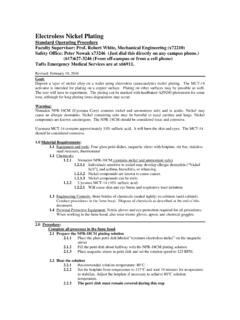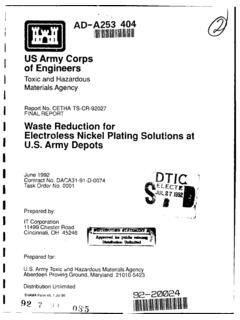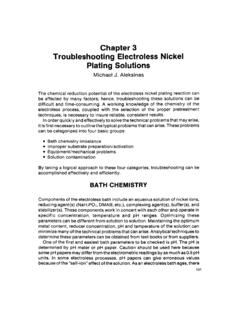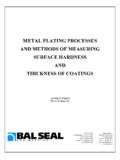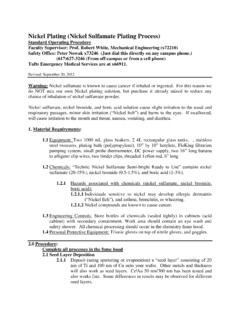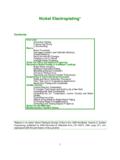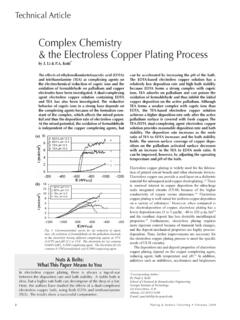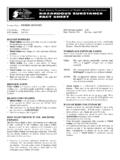Transcription of Wide range of applications High purity product Nickel ...
1 Wide range of applications high purity product N i c k e l S u l f a m a te " Nickel Sulfamate" is a highly precise and quality surface treatment chemical which utilized the outstanding plating characteristic. We have been accepting trust of the quality for over the years. Nickel Sulfamate bath is used for wide applications such as functional plating to following. Electronic components : Connector, Lead frame, Chip resistor etc. Electroforming products : Metal mask, Resin mold, Stamper, Diamond cutter etc. Advanced technique to control plating film properties such as precision and hardness, internal stress is required.
2 To meet these needs, we have various products of Nickel Sulfamates and additives. Features 1. high speed plating is possible more than general Nickel bath (Watts bath). 2. plating bath composition is simple, so control is easy. 3. Solubility to water is large. Use by high concentration and high current is possible. 4. Influence of impurities is slight. 5. Internal stress is very small, so suitable for various electroformings. 6. purity of our products is high , surface of the electrodeposit will be fine-grained. 7. Film properties of the electrodeposit are excellent in reproducibility under the same operating conditions.
3 Type and specification Nickel Sulfamate Concentration as Ni(NH2SO3)2 4H2O Specific gravity at 30 C pH Fe Cu Zn Pb Co max. 60% Nickel Sulfamate Solution > 900 g/L (60wt%) to 60% Nickel Sulfamate Solution ( high purity ) > 900 g/L (60wt%) to 65% Nickel Sulfamate Solution > 1,014 g/L (65wt%) to purity pH *1 Fe Cu Zn Pb Co max. Nickel Sulfamate > 96% *1 : Nickel Sulfamate 30g + Boric acid 3g + water 100mL Representative bath composition and operating conditions pH control Control the pH level of Nickel Sulfamate bath using following chemicals.
4 Add Sulfamic acid to decrease pH Add Nickel Carbonate to rise pH Attention for control of bath 1. The bath temperature is made into less than 70 C. Hydrolysis is caused when bath temperature exceeds 70 C, and formed Ammonium Sulfate deteriorates the film properties of the electrodeposit. Not to raise temperature locally, perform liquid circulation and use a heat exchanger. 2. Nickel containing sulfur with high solubility should be used for a positive plate. Nickel Chloride and a Nickel Bromide are used as an anode dissolving agent. When using anode dissolving agent in large quantities, Nickel Bromide shows the lower internal stress.
5 3. Inorganic and organic impurities rise internal stress, become brittle electrodeposition, and worsen film properties. Please be careful about the kinds of chemicals to use. Example of performance Please refer to the following data about Nickel Sulfamate plating and precision electroforming. In addition, the operating conditions are as follows. Normal high -concentration high -speed *2 Nickel Sulfamate 350 to 450 g/L 600 g/L 600 g/L *2 60% Nickel Sulfamate Solution 600 to 750 g/L 1,000 g/L 1,000 g/L *3 Nickel Chloride 5 g/L 5 g/L 5 g/L *3 Nickel Bromide 3 to 10 g/L Boric acid 30 to 40 g/L 30 to 40 g/L 40 g/L *4 Additives proper quantity proper quantity proper quantity *2 ,*3 : Initial make-up using either *4 : As necessary Bath temperature 40 to 60 C 40 to 60 C 40 to 60 C Cathode current density 1 to 10 A/dm2 1 to 45 A/dm2 45 A/dm2 max.
6 PH to to Filtration Continuous Continuous Continuous Heating tool heat exchanger heat exchanger heat exchanger Nickel Sulfamate 250 to 650 g/L Nickel Bromide 5 g/L Boric acid 30 g/L PITLESS S 5 mL/L pH Bath temperature 50 1 C Agitation Mild agitation, Cathode locker Current density 5 A/dm2 2 3 4 5 6 0 1 2 3 4 5 6 7 pH Addition amount [g/L] (Ref.) Relations of pH adjuster addition amount and pH Sulfamic acid Nickel Carbonate 1. Nickel Sulfamate concentration and internal stress, hardness Internal stress shows the minimum at Nickel Sulfamate ( Ni(NH2SO3)2 4H2O) concentration of 450 g/L (Figs 1 and 2).
7 Hardness shows the minimum between 350 to 450 g/L (Fig. 3). 2. Cathode current density and internal stress, hardness Initial internal stress rises with cathode current density rises. And internal stress becomes stable with plating film becomes thicker(Fig 4). Hardness decreases with cathode current density rises(Fig 5). When performing electroforming etc., cathode current density is set up low at the early stage, and if it rises to predetermined cathode current density, the effect of the prevention from exfoliation under plating or the crack prevention at the time of a mold release can be expected.
8 150 200 250 300 350 0 2 4 6 8 10 Hardness HV) Current density [A/dm2] Relations of Current density and Hardness 150 200 250 300 350 200 400 600 800 Hardness HV) Concentration of Nickel Sulfamate [g/L] Relations of Concentration and Hardness 200 400 600 800 1000 0 10 20 30 40 Internal Stress [kg/cm2] Time [minutes] Relations of Concentration and Internal stress 650g/L 550g/L 250g/L 350g/L 450g/L 200 400 600 800 1000 200 400 600 800 Internal Stress[kg/cm2] Concentration of Nickel Sulfamate [g/L] Relations of Concentration, plating thickness and Internal Stress 2 m 5 m 11 m 200 400 600 800 1000 1200 0 10 20 30 40 Internal Stress [kg/cm2] Time [minutes]
9 Relations of Current dencity and Internal Stress 8A/dm2 6A/dm2 4A/dm2 2A/dm2 3. Anode dissolving agent and internal stress, hardness Nickel Chloride and a Nickel Bromide are used as an anode dissolving agent of Nickel Sulfamate bath. The influence that those chemicals give in plating film properties are as follows. In low concentrations, internal stress is almost equivalent at addition of Nickel Chloride and addition of Nickel Bromide (Figs 6 and 7). However, to dissolve an anode reasonably and to stabilize a bath, it is necessary to make concentration of an anode dissolving agent higher.
10 At the high concentration, addition of Nickel Bromide shows the lower internal stress than addition of Nickel Chloride. Hardness is almost equivalent at addition of Nickel Chloride and addition of Nickel Bromide (Fig 8). 4. Ammonium ion concentration and internal stress, hardness By hydrolysis, Sulfamic acid generates Ammonium ion (NH4+) and a Sulfate ion (SO42-). NH2SO3 + H2O NH4+ + SO42 These ions degrade plating film properties. Internal stress becomes highest between 2 to 4 g/L of NH4+ concentration (Fig 9). Hardness rises with NH4+ concentration increase (Fig 10) and becomes the brittle film.

